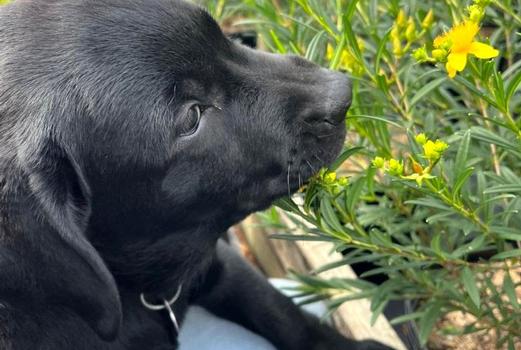Autumnal Awakening
It’s here! Chilly nights, chunky sweaters, candied apples, roasting bonfires, pumpkin spice everything… but lest we forget the late season blooming plants that add an extra bit of the ol’ razzle-dazzle to the fall landscape. What better to contrast the plentiful reds, oranges, and bronzy greens of Autumn than seasonal golden yellows and diverse purples? Besides: purple is a classic Halloween color, and yellow is an Autumn mainstay. Why not play it up this time of year and really lean into seasonal color palettes? Don’t worry, this week’s helpful guide to fun Fall flowers will do exactly that!
First up, the native perennial Liatris microcephala, which probably could’ve been included on last week’s list of long bloomers. Our Appalachian blazing star has been steadily producing its showy pink-purple flower spikes since July overtop a low-growing clump of soft, grass-like foliage that encourages you to run your fingers through it. The sensory appeal of Liatris microcephala extends from the physical touch of its strappy green leaves, to the low hum of native and honey bees that can be heard happily exploring the bountiful nectar within each tiny, star-shaped flower. Perfect for the sunny border with great drainage, or wherever a waterwise naturalistic planting style is desired, this diminutive blazing star will continue to bloom into early October. It has been shown to be an effective green roof specimen due to its penchant for drier soils and ability to tolerate drought once established. Flowers make excellent additions to fresh and dried cut arrangements, and are attractive to butterflies and hummingbirds.
Obviously, we can’t touch on fall favorites without mentioning at least one or two asters. This week, we’ve got ‘Eastern Star’ and ‘Avondale’ really beginning to come into themselves with their tiny, delicate flowers of white and pale blue. There is no shortage of fantastic things to be said about Aster divaricatus (syn. Eurybia divaricata) ‘Eastern Star’: dense blooms occur in partial shade to shady woodland areas, especially where it receives excellent drainage, although it is highly adaptable to a variety of difficult soil conditions. The small, white, daisy-like blooms begin to appear in late August and persist into early October over bronzy green foliage with rich mahogany stems. Butterflies and bees are frequent visitors to the yellow-to-reddish-purple center disk flowers, and several Lepidopterans make use of Aster divaricatus’ foliage as a larval host.
Since you’ll be busy prepping your space for your ‘Eastern Star’ white wood aster, make some room for ‘Avondale’ blue wood aster while you’re at it. Aster cordifolius (syn. Symphyotrichum cordifolium) ‘Avondale’ has many similar fantastic qualities to its white-flowering counterpart, including being tolerant of shade conditions and preferring well-drained soils, making it perfect for the woodland garden or anywhere that its naturalized form is encouraged. As with ‘Eastern Star’ white wood aster, the dried seedheads of ‘Avondale’ blue wood aster are eaten by songbirds such as goldfinches in the late fall and early winter, and the foliage is a means of support for the larval form of the Pearl Crescent butterfly. Game birds like wild turkeys and the Pennsylvania State Bird, the ruffed grouse, have been known to graze blue wood aster foliage in their natural woodland habitats.
When it comes to the yellows of the season, naturally most gardeners and horticulturists think of goldenrods, black and brown-eyed susans, and native sunflowers. However, the summery blooms of Hypericum kalmianum ‘Gemo’ shouldn’t be overlooked. With their fiberoptic centers and fluorescent yellow petals, the eccentric flowering habit of this small deciduous shrub persists from July into early October, first beginning as showy buds with prominent sepals and transitioning through their flowering period to eventually become attractive, reddish brown seed capsules that will remain on the plant often into Spring. Over time, the habit of this shrubby St. John’s wort can make a suitable low hedge. This particular variety is highly adaptable to rocky soils, urban sites, and somewhat moist woodland conditions.
Finally, while you’re curating your low-growing fall-themed hedge design, consider intermingling the fragrant, violet-blue blooms of Caryopteris x clandonensis ‘Longwood Blue’ amidst the golden yellows of Hypericum. Another perfect addition for the sensory, pollinator, or cut flower gardens, abundant and showy upright cymes of blue flowers begin to appear at the end of July and persist into late September and often early October. You better like bees if you’re going to be planting this one – the bee activity is so pronounced that it almost looks like the plants are moving if you stand and watch a large patch of Caryopteris for a moment. Attractive, velvety-looking, silvery-green foliage maintains a gentle and pleasant aroma throughout the growing season, encouraging interactions by passersby. Even the dried seed capsules are visually stimulating, making this plant a multi-seasonal standout that commands your attention without asking for too much maintenance.
Liatris microcephala smallhead blazing star from North Creek Nurseries
Liatris microcephala - Emory Knoll Farms Emory Knoll Farms (greenroofplants.com)
Liatris microcephala Appalachian blazing star from New Moon Nurseries (newmoonnursery.com)
Aster divaricatus 'Eastern Star' white wood aster from North Creek Nurseries
Eurybia divaricata 'Eastern Star' - Plant Finder (missouribotanicalgarden.org)
Aster cordifolius 'Avondale' blue wood aster from North Creek Nurseries
Hypericum kalmianum - Plant Finder (missouribotanicalgarden.org)
Hypericum kalmianum ′Gemo′ – Purdue Arboretum Explorer
Gemo St. John's Wort (Hypericum kalmianum 'Gemo') in Inver Grove Heights, Minnesota (MN) at Gertens

Abby checking out Hypericum kalmianum 'Gemo'






